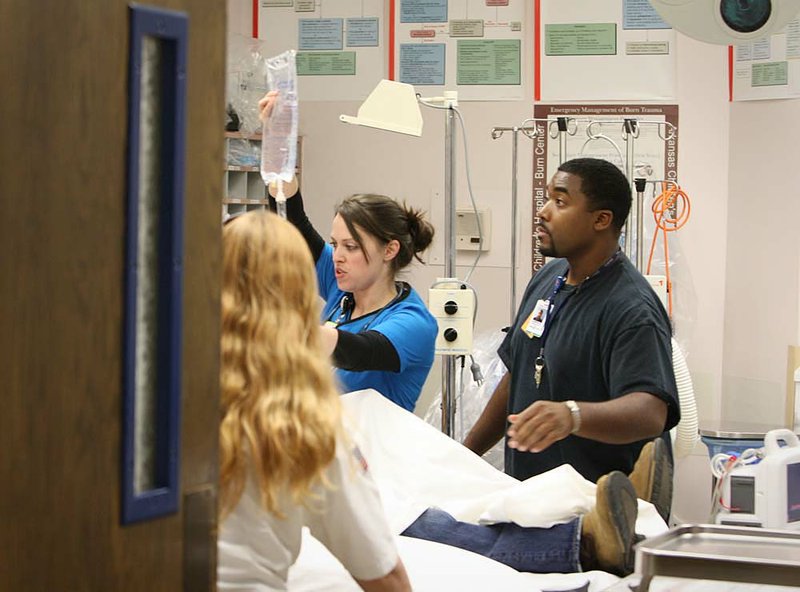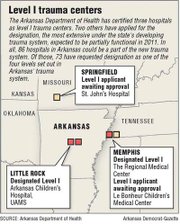LITTLE ROCK — The Arkansas Department of Health has designated Arkansas Children’s Hospital a Level I trauma center and the first targeted toward pediatric patients.
The hospital is the third to be named a Level I - the most extensive classification - and the fourth to officially join the state’s developing trauma system.
“We’re extremely happy that these hospitals are coming on board at the level that they are,” said Bill Temple, chief of the injury prevention and control branch of the state Department of Health.
“Since they offer the highest level of clinical care, the more Level Is and Level IIs you have around, the better the quality of care you have to offer traumatically injured around the state.”
The Arkansas Trauma System will connect emergency medical services statewide with the goal of getting patients the specific care they need as quickly as possible after injuries resulting from gunshot wounds, fires and automobile accidents.
Now, patients in many parts of the state are taken to the nearest emergency room, even if they have severe injuries - including head wounds - that can’t be treated at that facility.
Under the trauma system, patients will be routed directly to hospitals capable of treating their particular injuries.
Arkansas is among three states that don’t yet have fully operational trauma systems.
Arkansas’ injury-related mortality rate is 50 percent higher than the U.S. average, Health Department Director Paul Halverson has said. Organizers expect the trauma system to reduce injury-related deaths by at least 25 percent.
The system is funded by an increase in tobacco taxes that was signed into law in 2009, providing grants for training, hospital improvements and ambulance upgrades.
Eligible hospitals can seek one of four levels-of-care designations, with Level I being the most extensive and Level IV being the least demanding on a hospital’s resources.
Level I and II trauma centers are the most clinically intensive, Temple said. The designations require them to staff doctors from various specialties around the clock.
Level I centers face additional requirements in the areas of research, community education and injury prevention.
“It’s about getting every hospital to perform to its capacity,” said Dr. Todd Maxson, trauma director at Children’s and trauma consultant for the Health Department. “If you can get every hospital to perform to its capacity, then every citizen in the state has a safety net.”
Arkansas Children’s Hospital received the four-year designation after an extensive review by a three-member team of national trauma experts earlier this month. The team, assembled by the state Health Department, reviewed the hospital’s emergency room, operating room, intensive care unit, blood bank, radiology and rehabilitation programs, Maxson said.
To prepare for its trauma system status, Children’s hired two trauma directors and added nurse practitioners, care coordinators and operating room staff.
The Pediatric Level I designation required special overview of the hospital’s ability to factor the developmental needs of children - ranging from infants to teenagers - into their care, Maxson said.
The hospital, which already treats adults in the state’s only burn unit, may be required to treat some adult trauma patients if other Level I centers exceed capacity in the case of equipment failure, staffing shortages or large-scale events, he said.
“If the patient needs exceeded our collective resources in the city, Children’s would move beyond our pediatric only status and take on other patients,” Maxson said.
Trauma Nursing Director John Recicar said the hospital also provided additional training for its nurses and set up nationally recognized protocols for caring for children in emergency situations in preparation for the certification.
Arkansas Children’s Hospital will seek in 2011 Level I certification from the American College of Surgeons after a voluntary review by the national organization.
“It’s more prestigious, and it will show that we’re functioning at a higher level even than the state is,” Recicar said.
Gov. Mike Beebe announced in September the first three hospitals designated as trauma centers under the state’s system. The University of Arkansas for Medical Sciences in Little Rock and the Regional Medical Center at Memphis were designated Level I centers, and Jefferson Regional Medical Center in Pine Bluff was granted a Level II designation.
Of 86 Arkansas hospitals that qualify to join the trauma system, 73 have applied for some level of designation, said Temple, the Health Department branch chief.
A centralized communications center will be operational in January, first assisting in patient transfers between hospitals and eventually linking emergency medical providers throughout the state after they purchase a new radio system.
Metropolitan Emergency Medical Services, a central Arkansas emergency medical services provider, will organize the trauma system’s call center under a $906,000 contract renewable for up to six years.
Participating hospitals will be required to update their status on a chart that shows their capabilities in various treatments, such as imaging and treating burns.
The color-coded system will allow facilities to note if doctors are on staff, if emergency rooms are at capacity and if equipment is functioning to aid in transport decisions, MEMS Director Jon Swanson told the Governor’s Trauma Advisory Council in October.
Front Section, Pages 1 on 11/23/2010

